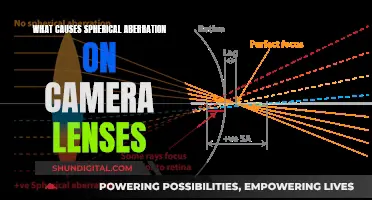
Polarized lenses for cameras, also known as polarizing filters, are a must-have tool for photographers. They are used to reduce reflections, glare, and haze in images, as well as intensify blue skies and saturate colours. They are especially useful for landscape photography, as they can enhance the blue of the sky, create contrast, and increase colour saturation. They are also beneficial for street and architecture photography, as they can improve the sky's contrast and colour, and reduce reflections from windows and shiny buildings.
Polarizing filters come in two varieties: linear and circular. Linear polarizing filters have one polarizing layer, while circular polarizing filters (CPLs) contain two layers, which repolarize the light that passes through. CPLs are more expensive but provide better performance as they do not interfere with autofocusing and metering technology.
When using a polarizing filter, it is important to note that they are most effective when used at a 90-degree angle from the sun. Additionally, they can make the exposure require 2-3 stops (4-8x) more light than normal, so adjustments to exposure may be necessary.
What You'll Learn

Polarized lenses reduce reflections and glare
Polarized lenses, or polarizers, are an essential tool for photographers, as they help reduce reflections and glare, enhancing the quality of images.
Polarized lenses work by filtering out polarized light, which is light that has bounced off non-metallic surfaces such as water, glass, or vegetation, and tends to reflect at the same angle. This results in a reflection, glare, or haze. By blocking this light, polarizers reduce the excess bright light and allow the colours of the object and surrounding landscape to come through. This increases colour saturation and improves contrast, creating more vivid images.
In addition to enhancing colours, polarizers can also be used to reduce atmospheric haze, allowing for clearer images, especially in landscapes. This is particularly useful for landscape photographers who often shoot in natural light and include the sky in their photos. By blocking the polarized component of skylight, polarizers create darker and more intense shades of blue, enhancing the overall image.
While polarizers can be incredibly useful, it is important to note that they are most effective when used at a 90-degree angle from the sun. They also require more time to set up and use, as they need to be rotated to adjust the level of polarization. Additionally, they can reduce the amount of light entering the lens, requiring adjustments to exposure settings.
Exploring the Intricacies of 35mm Camera Lenses
You may want to see also

They increase colour saturation
Polarizing filters are a must-have tool for photographers, enhancing colour saturation and making images appear more vivid and rich.
The filters work by reducing reflections and glare from non-metallic surfaces such as water, glass, leaves, and other non-metal surfaces. This reduction in glare and reflection allows for a greater fraction of the subject's light to be of the diffuse variety, resulting in a more colourful representation. In other words, by cutting down on the bright white light, the colours of the light and the object are allowed to come through. This is why foliage appears brighter green, skies appear a deeper blue, and flowers look more intense.
The effect of a polarizing filter cannot be replicated in post-production. It is one of those things that you either get right in-camera or don't get at all.
It is worth noting that saturation isn't always increased uniformly. This depends on whether a particular object is at an optimal angle to the sun, and whether this object is highly reflective. Generally, more reflective objects will see a greater increase in saturation when using a polarizer. Clear sunny days are also much more heavily influenced by polarizers than overcast or rainy days.
It is also important to remember that polarizing filters can make the exposure require 2-3 stops (4-8x) more light than normal, so you will need to adjust your exposure settings to compensate.
Cleaning Your Fujifilm XP Waterproof Camera Lens
You may want to see also

They improve contrast
Polarizing filters are a must-have tool for photographers, especially those shooting in natural light. They are used to reduce reflections, glare and haze in images, and intensify blue skies and saturate colours.
The filters work by blocking polarized light, which is light reflected from non-metallic surfaces such as water, glass, vegetation and asphalt. This results in photos that are less affected by reflections and glares, and have higher contrast and more vivid colours.
Polarizing filters can be particularly useful for landscape photographers, who often shoot in natural light and include the sky in their photos. The filters can enhance the blue of the sky, create contrast and increase colour saturation. As a result, landscape photos become picturesque with well-defined clouds and serene blue skies.
Polarizing filters can also be useful for nature photographers, who can use them to eliminate reflections and glares produced by bodies of water, dew or raindrops on vegetation, shiny rocks, and other non-metallic reflective surfaces. The filters can also increase colour saturation and contrast, which is particularly useful for photographing vegetation, such as flowers and fall foliage. Moreover, the polarizer filter removes the atmospheric haze and creates sharper and clearer photographs.
Street and architecture photographers also use polarizing filters, as they can block polarized skylight and improve the sky's contrast and colour, as well as eliminate reflections from windows and shiny buildings. The filters can also reduce atmospheric haze, which may affect sharpness and clarity, especially for long exposures.
Overall, polarizing filters improve contrast by reducing glare and direct reflections, which results in a more colourful representation of the subject. Foliage will be rendered with a brighter green, skies will have a deeper blue and flowers will appear more intense.
Camera Lenses: Sales, Deals, and Discounts
You may want to see also

They reduce haze
Haze is a common issue in landscape photography, especially when shooting distant subjects such as mountains. It can be caused by water vapour, pollutants, and other particulate matter in the atmosphere, which reduce visibility over long distances.
A polarizing filter can effectively reduce this haze, enhancing the clarity and sharpness of photographs. The filter does this by blocking random light waves from passing through, which would otherwise hit particles in the air and cause randomization, resulting in haze.
By reducing haze, polarizing filters allow photographers to capture distant subjects with greater detail and definition. This is especially beneficial for landscape, nature, and cityscape photographers, who often need to photograph subjects that are miles away.
For example, when photographing the Dubai skyline from over a mile away, a polarizing filter can help cut through the haze and fog, resulting in a sharper and more defined image. Similarly, when capturing the New York skyline through a helicopter window, a polarizing filter can improve the overall contrast and clarity of the scene by reducing internal reflections and haze.
It is worth noting that the effectiveness of a polarizing filter in reducing haze depends on its position relative to the sun. Polarizing filters are most effective when placed at a 90-degree angle from the sun. Photographers can use the position of the sun to determine how to angle their filter to achieve the desired effect.
In addition to reducing haze, polarizing filters also offer other benefits, such as enhancing colour saturation, reducing reflections, and improving contrast.
Best Cameras Compatible with Minolta Lenses
You may want to see also

They are especially useful for landscape photography
Polarizing filters are a must-have tool for every photographer, especially those who shoot landscapes. They are an effective way to enhance the vibrancy of colours and improve contrast in your photos.
Landscape photographers often shoot in natural light and include the sky in their photos. A polarizing filter can transform a dull photo lacking contrast and colour into a vivid, artful creation. It reduces atmospheric haze and allows you to take beautiful pictures in harsh sunlight. It also blocks the polarized component of skylight, creating darker and more intense shades of blue without affecting the rest of the frame.
Landscape photos become picturesque with well-defined clouds and serene blue skies. The filter also removes the atmospheric haze and creates sharper and clearer photographs.
Polarizing filters are also useful for landscape photographers who want to eliminate reflections and glares produced by bodies of water, such as lakes and oceans, or dew and raindrops on vegetation. The wet rocks surrounding a waterfall, for example, may create unpleasant reflections that distract from the main subject.
In addition, a polarizing filter can increase colour saturation and contrast. It is particularly useful for photographing vegetation, such as flowers and fall foliage.
The maximum effect of a polarizing filter occurs when your line of sight is perpendicular to the direction of the sun. This means that you should never use a polarizer facing directly toward the sun.
The effect of a polarizing filter cannot be replicated in post-processing. It is one of those things you either get right in-camera or don't get at all.
Preventing Camera Lens Fog: Tips for Clear Shots
You may want to see also
Frequently asked questions
A polarizing lens is a filter that blocks polarized light, which is light reflected off non-metallic surfaces such as water, glass, vegetation, and asphalt.
A polarizing lens reduces reflections and glare, increases colour saturation, deepens blue skies, and reduces haze.
A polarizing lens is ideal for reducing reflections and glare on water and glass, enhancing the sky's blue colour, increasing colour saturation, reducing haze in landscapes, and minimizing reflections on wet surfaces.
A polarizing lens is not ideal for low-light conditions, or when shooting with the sun directly behind you. They are also not suitable for capturing metallic surfaces as the light reflected off these surfaces is not polarized.
There are two types of polarizing lenses: linear and circular. Linear polarizing lenses have one polarizing layer, whereas circular polarizing lenses have two. Circular polarizing lenses are more expensive but provide better performance as they do not interfere with autofocusing and metering processes.







